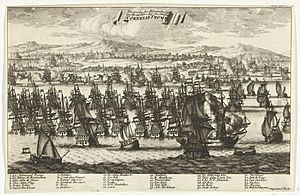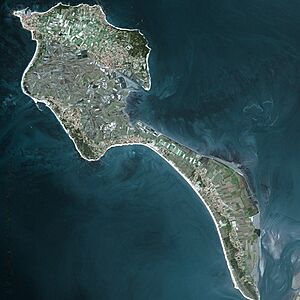Capture of Noirmoutier facts for kids
Quick facts for kids Capture of Noirmoutier |
|||||||
|---|---|---|---|---|---|---|---|
| Part of the Franco-Dutch War | |||||||
 Capture of Noirmoutier by Bastiaen Stopendael |
|||||||
|
|||||||
| Belligerents | |||||||
| Commanders and leaders | |||||||
| Strength | |||||||
| 800 soldiers 6000 Armed farmers another regiment of 400 people 30 canons unknown number of ships |
40 ships 3200 soldiers(100 or more did not participate in the landing) |
||||||
| Casualties and losses | |||||||
| 1 Frigate captured 2 other Vessels Unknown number of Fishing boats Unknown number of other ships unknown number of dead |
8-10 dead, 40-45 wounded 45 dead, 65 wounded (Sources differ) |
||||||
The Capture of Noirmoutier happened on July 4, 1674. During this event, a Dutch fleet led by Cornelis Tromp took control of the island of Noirmoutier. This battle was an important part of the Franco-Dutch War.
Contents
Why the Dutch Attacked Noirmoutier
The Capture of Noirmoutier was part of the Franco-Dutch War. This war began in 1672 when France invaded the Dutch Republic. By the end of 1673, the Dutch had successfully pushed the French forces out of their country.
This victory allowed the Dutch to change their strategy. Instead of just defending, they decided to go on the attack. A powerful Dutch fleet, led by Admiral Cornelis Tromp, was sent to cause trouble along the French coastline. Their goal was to disrupt French activities and gain an advantage in the war.
The Attack on Noirmoutier Island
The Dutch fleet set sail for Noirmoutier on July 2, 1674, and arrived the next day. Noirmoutier is an island located near the mouth of the Loire River, making it a key strategic spot. The Dutch first sent a small boat, called a sloop, to scout the island.
After gathering information, the Dutch leaders held a meeting. They decided to launch a full attack on July 4. The plan was for the naval fleet to provide cover while soldiers landed on the island.
Noirmoutier Island was well-defended by French forces. There were about 800 French soldiers, 30 cannon, and many ships. About 6,000 armed farmers and another group of 400 French soldiers also helped defend the island.
When the Dutch ships reached the shore, the attack began quickly. Dutch soldiers jumped into the water and waded to the island. More sloops were used to help the landing, and the Dutch quickly overcame the first French defenses. The French forces had to retreat through a narrow passage to Poitou.
There are different reports about how many Dutch soldiers were hurt. Some say 8 to 10 died and 40 to 45 were wounded. Other reports suggest 45 died and 65 were wounded.
Around 7 o'clock in the morning, the Dutch army, led by Van Hoorne, moved further inland. When they reached the castle, the French flag was taken down. The Dutch Prince's Flag was then raised, showing that the island was now under Dutch control.
After the Capture
After taking the island, the Dutch naval fleet anchored near a windmill. They spread their troops across Noirmoutier to secure the area. There were rumors that a large French force of about 5,000 soldiers might try to retake the island. The Dutch sent out teams to check for this possible counterattack.
During these checks, the Dutch captured two French ships. The people on these ships didn't know that the Dutch had taken over the island. The captured ships and their cargo were then taken by the Dutch forces.
Admiral Cornelis Tromp and other admirals visited the soldiers on shore many times. They wanted to make sure the soldiers followed the rules. Some soldiers were not following orders and were taking things from houses. Tromp tried to stop this behavior.
On July 9, six church bells were taken from the island. They were sent back to the Dutch Republic. Two of these bells were placed in churches in Oud-Loosdrecht and Kortgene.
The Dutch stayed on Noirmoutier for about three weeks. On July 23, Admiral Tromp decided it was time to leave. Before they left, they destroyed the castle and its defenses. They also took 18 French people with them as a way to get money later. The Dutch demanded 35,000 guilders for their return.
On July 26, the Dutch fleet sailed away from Noirmoutier. There were still rumors that 10,000 French soldiers were coming to retake the island, but no such force appeared. Later, a Dutch commander named Van Nes returned to Noirmoutier to collect the payment for the captured French people. However, the island's citizens told him that Tromp had given them four months to pay. Van Nes was confused because he had not received this information, showing that communication between the Dutch commanders was not always clear. He then left the island.
Images for kids



